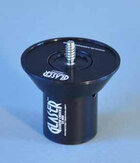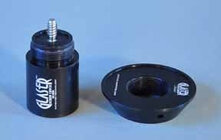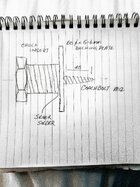I bought a Vicmarc VM150 chuck to use on my new 25” lathe. What is the maximum bowl blank size can I mount using the VM150’s woodworm screw? I.e. when should I switch to a faceplate or faceplate ring?
-
December 2025 Turning Challenge: Single Tree! (click here for details) -
Congratulations to Bob Henrickson, People's Choice in the November 2025 Turning Challenge (click here for details) -
Congratulations to Steven Gordon for "Dropped Ice Cream Cone" being selected as Turning of the Week for December 8, 2025 (click here for details) -
Welcome new registering member. Your username must be your real First and Last name (for example: John Doe). "Screen names" and "handles" are not allowed and your registration will be deleted if you don't use your real name. Also, do not use all caps nor all lower case.
You are using an out of date browser. It may not display this or other websites correctly.
You should upgrade or use an alternative browser.
You should upgrade or use an alternative browser.
Max bowl blank size for a woodworm screw?
- Thread starter Gerald Page
- Start date
- Joined
- Apr 27, 2004
- Messages
- 9,303
- Likes
- 6,058
- Location
- Lakeland, Florida
- Website
- www.hockenberywoodturning.com
personally I only use the screw for platters and small pieces where I want to turn something inside the tenon before hollowing.
Large pieces I would do between centers.
I haven’t done really large pieces
Maybe a 1/2 dozen 20” bowls.
A couple 17” diameter hollow forms
Lots of 14-15” diameter natural edge bowls
Large pieces I would do between centers.
I haven’t done really large pieces
Maybe a 1/2 dozen 20” bowls.
A couple 17” diameter hollow forms
Lots of 14-15” diameter natural edge bowls
I use a screw on a 24" bowl. However I always use the tailstock on larger pieces.
Too, it depends on multiple factors. E.g. What are you turning. Is the wood in good condition or punky. Well balanced or irregular blank. Can you keep the tailstock engaged. If you feel it's precarious, change your plan.
That said I have turned 12 x 12 x 6 well balanced, solid wood with tailstock.
A suggestion when using a screw chuck, don't use electronic (or mechanical) braking.
That said I have turned 12 x 12 x 6 well balanced, solid wood with tailstock.
A suggestion when using a screw chuck, don't use electronic (or mechanical) braking.
- Joined
- Jul 18, 2018
- Messages
- 1,328
- Likes
- 2,862
- Location
- Baltimore, MD
- Website
- loujacobswoodturning.com
As long as the tailstock is used, no limit.
For my first large-ish bowl I was starting out with a 12” x 3” block of a solid maple round that I picked up at Rocklers. (I just upgraded from a Jet 10-14 that I’ve used for the last 20+ years). It sounds like a woodworm screw is just fine, as long as I start with the tail stock.Too, it depends on multiple factors. E.g. What are you turning. Is the wood in good condition or punky. Well balanced or irregular blank. Can you keep the tailstock engaged. If you feel it's precarious, change your plan.
That said I have turned 12 x 12 x 6 well balanced, solid wood with tailstock.
A suggestion when using a screw chuck, don't use electronic (or mechanical) braking.
Good advice on the electronic brake…
Thx
Last edited:
I have used the same Nova woodworm screw for over 20 years. I have had 2 Oneway screws break and have never tried the Vicmarc screw as it looks to thin for me. I now always use the tailstock with the screw after having those Oneway screws break.
Roger Wiegand
Beta Tester
I've gone up to 20-24". Never tried such a thing without the tailstock in place.
I never use a wood worm screw. I do have 2 5/8 inch forstner bits and drill a recess first and expand my Vicmarc chuck into that. Easier. Biggest I ever did was 22 inch diameter. I think I used the tailstock for that one. Most of the time, it is sufficient for blanks up to 14 inches, even 16 inch, but those don't sell for me. With any blanks under 14 inch, I never use the tailstock. That may be an "advanced" skill....
robo hippy
robo hippy
I’ve used the Nova screw many times without issue, but my bowls were limited to the size of my old 10” lathe. The Vicmarc VM150 screw is long, and does seam thin for its size… it protrudes 1-3/8” beyond my standard jaws. Hope to try it out todayI have used the same Nova woodworm screw for over 20 years. I have had 2 Oneway screws break and have never tried the Vicmarc screw as it looks to thin for me. I now always use the tailstock with the screw after having those Oneway screws break.
Last edited:
The Vicmarc VM150 screw is long, and does seam thin for its size… it protrudes 1-3/8” beyond my standard jaws. Hope to try it out today
If too long for a shallow bowl or platter, it's common to limit the depth by shiming between the chuck and the wood with plywood disk(s). But you prob already know that.
Was needed on this platter.

The screw for the Glaser screw chuck also seems thin but is tough, hardened steel and machined with quite sharp threads, nothing like the fairly crude threads on my Nova wormwoods. I drill a 1/4" hole the diameter of the central shaft and screw in the chuck in by hand. Holds incredibly well.
JKJ
While the manufacturer (or their attorney) probably specifies the maximum size, I would say it boils down to the how solid is the particular piece of wood and your tolerance of pucker factor. Personally, 12 or 13" is about as large as I go with the wood that we get locally.
Nice looking platter!If too long for a shallow bowl or platter, it's common to limit the depth by shiming between the chuck and the wood with plywood disk(s). But you prob already know that.
Was needed on this platter.
View attachment 78660
The screw for the Glaser screw chuck also seems thin but is tough, hardened steel and machined with quite sharp threads, nothing like the fairly crude threads on my Nova wormwoods. I drill a 1/4" hole the diameter of the central shaft and screw in the chuck in by hand. Holds incredibly well.
JKJ
Fortunately my blank is 3" thick, so the 1-3/8" X 5/16" hole I drilled should be easily be erased by the time I've finished the bowl.
How thick do you leave your bottom when you drill with the forstner?I never use a wood worm screw. I do have 2 5/8 inch forstner bits and drill a recess first and expand my Vicmarc chuck into that. Easier. Biggest I ever did was 22 inch diameter. I think I used the tailstock for that one. Most of the time, it is sufficient for blanks up to 14 inches, even 16 inch, but those don't sell for me. With any blanks under 14 inch, I never use the tailstock. That may be an "advanced" skill....
robo hippy
I was wondering about the center point of the forstner and how close the hole would get when hollowing the inside?
I can see myself making a drain hole for a flowerpot. (it's happened before, usually with a tailstock point)
How thick do you leave your bottom when you drill with the forstner?
I was wondering about the center point of the forstner and how close the hole would get when hollowing the inside?
If thickness is a problem, you can grind off the center point of a forstner bit and it will still work, easy in a drill press. I prefer to work in an entirely different way, but we are all different! (Yikes, what a concept!)
For tailstock support, I'm a fan of live centers that have spring loaded points. The points are more for alignment than holding. I use the Steb centers but there are others. Many also have removable points, leaving just a cup. Still holds.
I use the screw chuck on many blanks for several good reasons (perfect for the way I work) but there are other methods. What you use depends on lots of things - the shape of the blank you start with (flat on one or both sides, irregular (burl?), balanced, unbalanced), dry or wet log section, solid or full of cracks and voids, what tools you have on hand or are willing to acquire, the kinds of chucks and jaws you keep, your level of experience, more ....
Knowing more might bring more useful ideas.
JKJ
John, I am interested in your approach. Can you explain your method please. ThanksIf thickness is a problem, you can grind off the center point of a forstner bit and it will still work, easy in a drill press. I prefer to work in an entirely different way, but we are all different! (Yikes, what a concept!) . . . . . .
JKJ
Sam, how deep I go with the forstner bit depends on if I am turning plates or bowls. With bowl slabs, especially ones I will core, I generally go 1/2 inch or so. Since bowl blanks can be a bit uneven when cut with the chainsaw, I drill so that the face of the blank sits on the edges of the chuck jaws, that flat outside where the chuck jaws come up. This makes the top side more even, and the bottom a bit wider. For plate stock, I might go down 1/4 inch which is more than enough to securely hold just about any plate I turn, which is up to about 12 inches. I have not really done any great big, like 16 inch platters. I might go a bit deeper for them, but again, the blank would be thicker. I would not remove the point in the center of a forstner bit. Mostly that is the marker I use to center the bit on the compass center point. I guess I could scribe a 2 5/8 inch diameter circle, but that would be an extra step in production that is not needed.
Is it just me, or do plate/platter blanks tend to get more harmonic vibrations than bowls?
robo hippy
Is it just me, or do plate/platter blanks tend to get more harmonic vibrations than bowls?
robo hippy
The size itself is not limited. It is the weight and the balance that could give you issues, but those improve considerably when you use the tailstock.I bought a Vicmarc VM150 chuck to use on my new 25” lathe. What is the maximum bowl blank size can I mount using the VM150’s woodworm screw? I.e. when should I switch to a faceplate or faceplate ring?
Once you introduce speed, you will see how off balance your piece is, and you'll need to adjust. Enjoy your turning & stay safe!
I've never experienced a face plate failure but with several worm screw misses...if you decide you like them let me know and i'll send you several.
I use woodworm screws quite a bit, I've got a few on hand. The only one I had that ever broke was one that came with a Harbor Freight chuck that I purchased. Others I got through Grizzly and Nova. They work well. 
 ️
️
I have lost a Nova screw once. Now I have made a series of backing plates 3, 4, 6" the slide on the worm screw. I find the extra flat backing area helps a great deal in stopping side movement which is a bit of a killer on screw chucks.
Similarly, I will sometimes use a larger jaw set with the woodworm screw, e.g. 70mm, 100mm.I have lost a Nova screw once. Now I have made a series of backing plates 3, 4, 6" the slide on the worm screw. I find the extra flat backing area helps a great deal in stopping side movement which is a bit of a killer on screw chucks.
If thickness is a problem, you can grind off the center point of a forstner bit and it will still work, easy in a drill press. I prefer to work in an entirely different way, but we are all different! (Yikes, what a concept!)
John, I am interested in your approach. Can you explain your method please. Thanks
@Alan Heffernan, sorry, I just noticed your question.
After trying most of the methods I've seen, read about, and was taught, I now start all bowls, platters, and other face-oriented turnings with what I call the "Permanent Recess Method". This method is not much use for end grain turnings such as vessels and boxes. Basically, make a recess in the bottom such that it might look respectable. I'll try to list the steps. This will take longer to write than it would be to demonstrate!!
IMPORTANT NOTE: I almost always turn dry wood since that's what I like. I generally prefer nice wood without voids and cracks. Like most, I do like figured swirls and burls.
I'm definitely not a certified member of the crowded big wet wood bowl club. I might do a twice-turned bowl every 5 years or so to just because. Only rarely a natural-edge or other green wood piece, last time maybe 15 years ago. Piece diameter is almost always under 12", maybe 8" to 16".
I'll put a few photos below, all of which I've posted here in past threads.
(I wrote a document on this but I choose not to upload for now since I plan to do more demos on one of my designs using this method.)
Primary Tools used
- Glaser screw chuck
- Scroll chuck, mostly with 50mm jaws
- Spindle and bowl gouges
- Hunter Hercules tool
- Various negative rake scrapers (NRS)
- Hand scrapers
- Sandpaper backed with a flexible eraser
- Flatten what will be the top in some way, at least enough to use the Glaser screw chuck shown in post #8. If starting with a blank cut from a thick plank, the easiest thing for me is to run top and bot through my drum sander with 60 grit - makes nice flats on both sides.
- Mark the center of the top and drill a 1/4" hole needed by the Glaser (a tiny bit deeper than the screw on the Glaser) for clearance. If a plate or platter is very thin, calculate how deep the hole can be and plan on using a spacer. Note: I always drill with the drill press, not a hand-held drill so there is no chance angling the hole even a tiny bit - that could compromise the holding.
- Thread the chuck into the hole and mount on the lathe. The Glaser has the best threads I've seen and holds extremely well.
- Support what will be the bottom with the tailstock. True up the outside (for a bowl and round platter.
- If necessary (for a blank from a board/slab not drum sanded top and bottom) flatten what will be the bottom as much as possible with the tailstock support.
- Mark the diameter of the foot or bottom and rough turn the bottom from the foot to the rim.
- Remove the tailstock support. Slightly dish inside the foot and turn a clean, narrow rim on the foot so the piece will sit flat on the table.
- Refine the outside of the bottom from the foot to the rim. Remove tool marks with a curved NRS.
- Turn a straight-sided recess in the bottom just large enough and wide enough to fit the 50mm jaws on my Nova chucks. Depending on the wood and my mood and I make this recess from 1/8" to 1/4" deep.
- Detail inside the foot and inside the recess. Flatten the bottom of the recess ring with a narrow NRS and sand. This will show in the finished bottom. (Provides a great little "shadow box" effect for the signature.)
- Remove the piece from the lathe leaving it mounted in the Glaser screw chuck.
- Mount the piece by the Glaser chuck onto a Best Wood Tools carving and finishing stand in the banjo. Use hand scrapers and hand sanding to smooth the outside. Smooth and sand inside the foot.
- Apply finish to the entire bottom. I almost always use "danish" oil, applying the first coat at this point. Let the oil dry.
- Remove the piece from the Glaser screw chuck and mount it on the lathe by the recess in the bottom.
- Turn/hollow out the inside of the top of the platter or bowl. Remove tool marks with the curved NRS. Examine carefully and feel for irregularities including a mound or divot in the center. If present, remove them by either careful turning, shear scraping, or with a hand scraper. I usually don't use a conventional scraper especially in the hollow to avoid the risk of tearout with some species.
- If the rim is round, as on a bowl, use NRS, hand scrapers and/or sandpaper to smooth.
- Remove the chuck from the lathe with the piece still attached and mount on the BWT stand.
- Smooth the inside with hand scrapers and hand sanding. If the rim is not round, smooth and sand this by hand. Sanding sticks are helpful.
- Apply 1st coat of oil on the inside/top.
- Remove from the lathe and apply more coats of oil on the entire piece over the next few days or weeks. On occasion I will wet sand with oil with 600 grit or with 0000 Liberon steel wool. I'm not a big fan of high gloss.
NOTE ABOUT SANDING: I quit using rotating sanding disk on drills years ago. I didn't like the clouds of dust, how it could wipe out deatail, and didn't like what it did to the wood in some cases. The NRS and hand smoothing always work for me.
After smoothing and hand sanding I do sometimes use a small pneumatic random sander (off the lathe) running at a very low speed, always with fine paper disks, usually 600 or 800 grit. Then more hand sanding if needed and maybe fine steel wool.
Preparing and using hand scrapers is an entire topic in itself. It's amazing how well and quickly they work when properly prepared. I've been preaching from my "hand scraper soapbox" for years and now know some who use them. Since hand scraping can leave quite smooth surfaces, I can usually start with 400 grit paper, sometimes 320, occasionally 600.
I've had woodturning polilce tell me it was illegal (or maybe shamefully immoral) to leave evidence of the holding method in the bottom of a piece. That may be true for them. I've not yet had someone turn one of these over and not say something positive - most say something nice like "Nice!". No one has ever refused one as a gift. I fact, a gentleman who was once quite vocal about not leaving a recess in the bottom now has one of my bowls made with this method - after begging to buy it my wife said to just give it to him.
Some photos. As you can see, I do like to make what I call my "small squarish dished platter" design. I've done demos on this in maybe 6 or 7 clubs, and taught the design and the method of work listed above to a number of students and turners. Many have made them. One gentleman made over a dozen in a row. One friend who lives in the far frozen north did demos on these in his area - I'm too lazy to travel that far!
Also, I'm a proponent of creating composite photo compositions to work within the 4-photo forum limit. I use Photoshop.
One small squarish dished platter. Maple.
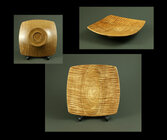
Composite of a few round platters from Sapele, one with a multi-axis base (shows the permanent recess if you look hard enough.)
The two largest are about 19" in diameter.
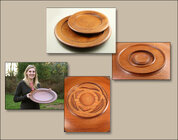
Composite of various pieces made with the "Permanent Recess Method."
One is a fairly new student's first real piece, a gift for a sister. The rest are mine.

Composite of hand scraping, a few scrapers, and NRS. I use hand scrapers on almost everything I turn except spindles.
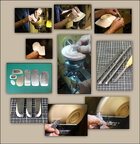
Hope this sort of explains how I do such things these days.
JKJ
Another way perhaps is a larger dia worm for the big pieces. I am in the process of making one with a 12mm ( 1/2" dia) x 45mm long. No images as yet as im in Bali for a few days . But will sketch it up and post a description
I do this as well, Forstner bit to 1/2" to 3/4" over Vicmarc shark jaws. The shark jaws give me a bit of flexibility if I want to re-orient.Sam, how deep I go with the forstner bit depends on if I am turning plates or bowls. With bowl slabs, especially ones I will core, I generally go 1/2 inch or so. Since bowl blanks can be a bit uneven when cut with the chainsaw, I drill so that the face of the blank sits on the edges of the chuck jaws, that flat outside where the chuck jaws come up. This makes the top side more even, and the bottom a bit wider. For plate stock, I might go down 1/4 inch which is more than enough to securely hold just about any plate I turn, which is up to about 12 inches. I have not really done any great big, like 16 inch platters. I might go a bit deeper for them, but again, the blank would be thicker. I would not remove the point in the center of a forstner bit. Mostly that is the marker I use to center the bit on the compass center point. I guess I could scribe a 2 5/8 inch diameter circle, but that would be an extra step in production that is not needed.
Is it just me, or do plate/platter blanks tend to get more harmonic vibrations than bowls?
robo hippy


